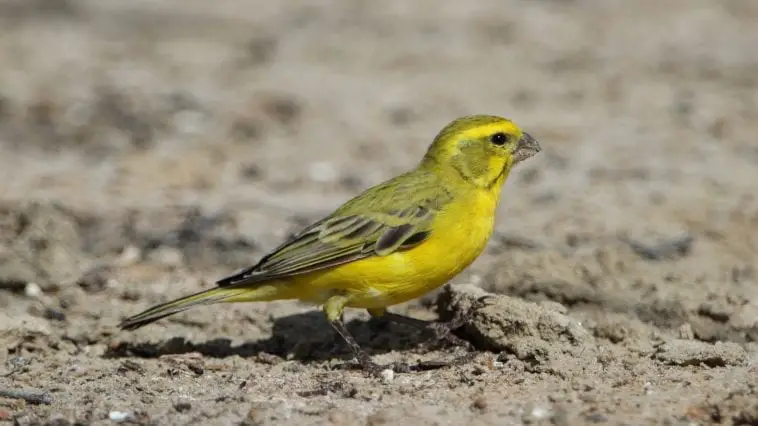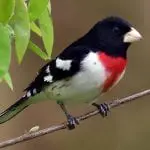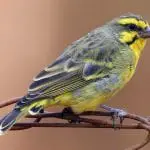Scientific Facts
| Common Name | Yellow Canary |
| Scientific Name | Crithagra flaviventris |
| Lifespan | Over 10 Years |
| Size | 10 – 15 cm. |
| Mass | 12 – 30 grams |
| Habitat | Coastal valley scrub, Mountain valley scrub, karoo |
| Range | South Africa |
Information & Physical Appearance
The yellow canary (Crithagra flaviventris) is part of the order Passeriformes, the family Fringillidae, the subfamily Carduelinae, the genus Crithagra.
Back in time, the yellow canary used to be placed in the genus Serinus. However, thanks to cut-edge phylogenetic analysis that made use of both nuclear and mitochondrial DNA sequences, the genus was discovered to be polyphyletic. Because of this, the genus was then split, and a number of species, including but not limited to the yellow canary, were reclassified into the genus Crithagra.
The yellow canary is a small-sized bird that reaches about 13 cm in length on average. In adult male yellow canaries, the overall body coloration varies from almost completely, uniformly yellow to Olive-backed, beautifully streaked.
It is male yellow canaries inhabiting the northwest of their range to exhibit almost fully yellow coloration, while the males inhabiting the southeast of these birds’ range are the ones to be streaked and Olive-backed.
Males’ tail sides are yellow in color, and so are the underparts and the rump.
In females, the upper parts display grey-brown coloration, while the yellow flight feathers wonderfully contrast the black wings. The stripe that runs from the base of the beak, just above the eye, and finishes towards the rear of the bird’s head (aka the supercilium) is pale. The white underparts feature brown streaking.
Immature yellow canaries resemble the physical appearance of the adult female. However, in juveniles, the streaking is visibly heavier.
One of the confusion species, especially when taking into consideration the overlapping range, is none other but the brimstone canary (Serinus sulphuratus).

Brimstone canary – Image Source
Another similar bird species is the Yellow-fronted Canary (Serinus mozambicus). However, the Yellow-fronted canary is easy to distinguish from the yellow canary as the latter is lacking the black facial markings.
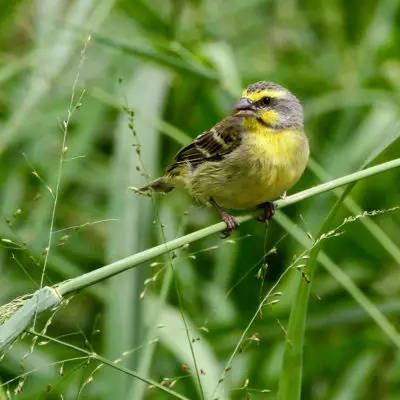
Yellow-fronted canary – Image Source
The yellow canary’s bill is significantly less heavy than the bill of other similar Crithagra species.
Lifespan

Similarly to all other canaries, the yellow canary can live for more than 15 years in the wild, as long as the bird is to manage to find a good food supply while staying away from possible predators.
In captivity, the average life expectancy of the yellow canary is estimated at between 9 – 10 years. However, when provided with proper care, individual yellow canary birds can easily live up to 15 years.
Ecosystem & Habitat
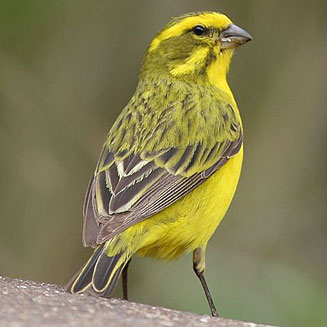
The yellow canary is known to inhabit the mountain or coastal valley scrub, as well as South Africa’s semi-desert natural region – the karoo. As represented by fossils, the karoo has hosted an especially well-preserved, unique ecosystem all the way back to hundreds of million years ago. The karoo is mostly defined by its cloudless skies, arid air, low rainfall, and nonetheless, cold and heat extremes.
The yellow canary is a resident breeder in a huge portion of southern Africa’s central and western regions.
Additionally, the yellow canary has been successfully introduced to St. Helena islands, and to Ascension.
Food & Diet
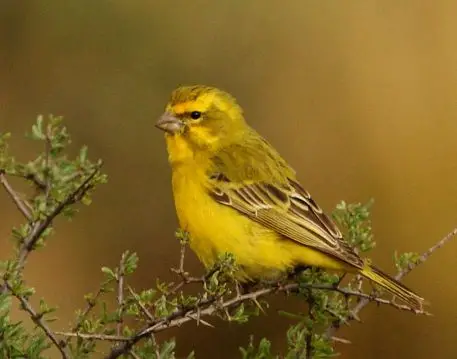
The yellow canary has built a solid reputation as a fairly common, gregarious seedeater.
Although a wide variety of seeds make up for the majority of the yellow canary’s diet in the wild, it is seasonal changes to dictate food availability. Therefore, this bird species is also known to take insects, as well as certain fruits, vegetation, and berries throughout the year.
Behavior
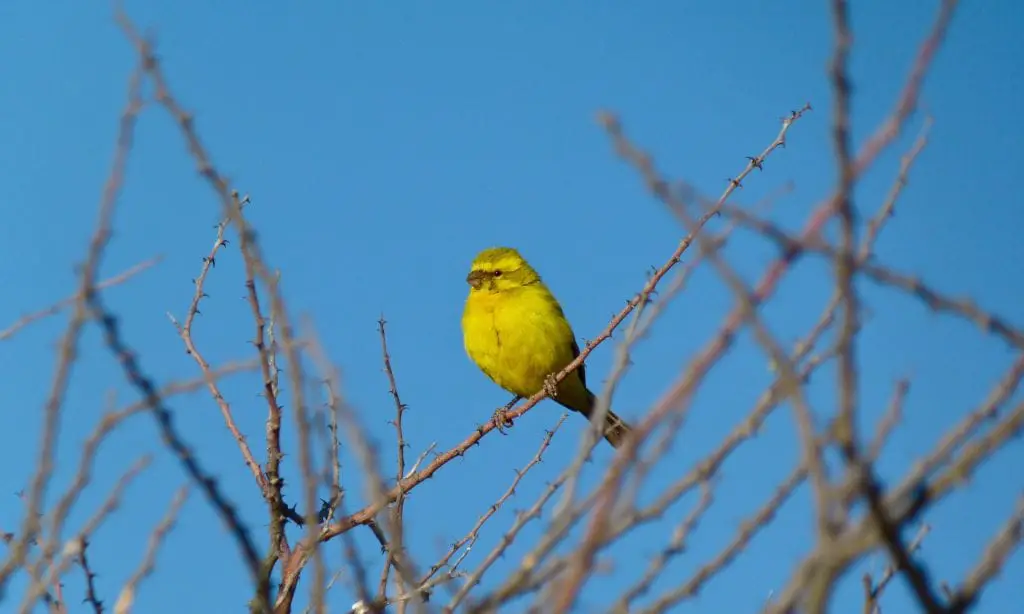
Outside the breeding season, canaries are known to behave as quite solitary birds. However, they are to form flocks when it comes to feeding together. They spend most of their active time engaged in foraging.
All canaries, including but not limited to the yellow canary, and regardless of whether it comes to wild or domesticated varieties, are diurnal creatures; hence, they are active only during the day.
Reproduction

Yellow canaries build their nests in a suitable scrub. The nest is compact and shaped like an open cup. Each clutch consists of between 3 and up to 7 eggs. The incubation period lasts for about two weeks.
Possible Health Issues
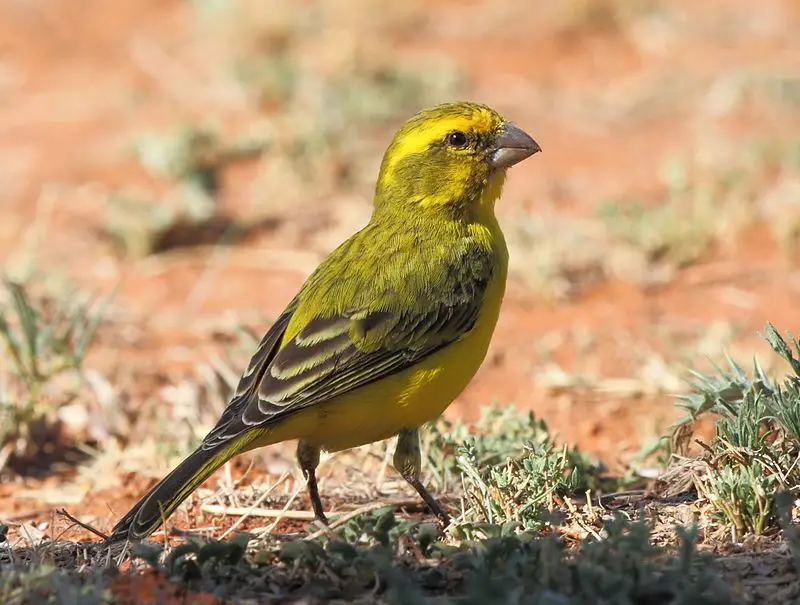
Yellow canaries kept as pets may suffer from various health issues. However, these feathery fellows are considered quite hardy birds. Almost all possible illnesses can be prevented from ever happening, as they are most frequently due to dirty cages, drafts, and/or improper diet.
The best way to prevent most canary illnesses sums down to providing a very balanced diet, along with plenty of exercises.
Additionally, the caregiver should know his/her bird very well, as to be able to quickly notice any potential signs of illnesses, such as a rapid loss of weight.
Illness Signs
1. Droppings are not white and black.
2. Lack of appetite
3. Molting out of season
4. Ruffled, fluffed, soiled, or plucked feathers
5. Wheezing/ Coughing/ Runny or discolored stools/ Nasal or eye discharge
6. The bird does not sing
7. The bird acts run down and feeble/ Sitting on the floor of the cage
8. Beak accumulations or swelling
9. Swollen /red eyes
10. Favoring only one foot (sleeping on one foot is fine, though).
If the caregiver is to notice any of these signs, a qualified veterinarian should be contacted as soon as possible.
In the case of diarrhea, it is often an incorrect diet to blame, yet there might be many other causes, including but not limited to internal parasites, so it remains a must to consult a veterinarian.
In the case of feather or lice mites, the habitat must be carefully and thoroughly cleaned, and then again, a veterinarian should be consulted for further guidelines. Lice or feather mites lead to scratching, feather picking, and restlessness in general.
In the case of mites leading to leg disease or scaly face, a veterinarian should be consulted immediately. The symptoms include white deposits occurring on the beak, feet, legs, and eyes.
Avian pox may also affect yellow canaries, with those raised outdoors being the most susceptible to avian pox-related issues. The symptoms include visible lesions occurring in the mouth, as well as scabs on the face and on the eyes. The infected bird should be isolated as soon as feasible, followed by contacting a veterinarian.
Common Illnesses and Injuries
1. Cuts and open wounds
2. Broken legs and/or wings
3. Feather lumps (ingrown feathers).
4. False molt (caused by poor diet and/or mishandling).
5. Leg cramps (due to confining the bird in a cage that is too small in size).
6. Feather picking
7. Overgrown nails and/or beaks
8. Shock
9. Egg binding
10. Weight loss
11. Heatstroke
12. Concussion
13. Diarrhea
14. Colds
15. Baldness
16. Mites
17. Sore eyes
18. Scaly legs
19. Constipation
20. Tumors
21. Loss of song
Signs of a Healthy Yellow Canary
- Good appetite (the bird drinks and eats gladly throughout the day).
- Bright, dry eyes. Dry nares.
- Alert, sociable, and active
- The feathers are well-groomed and visibly smooth
- The vent is dry and clean
- The legs, feet, and the beak do not display any abnormal signs
Availability – Where to Get a Yellow Canary
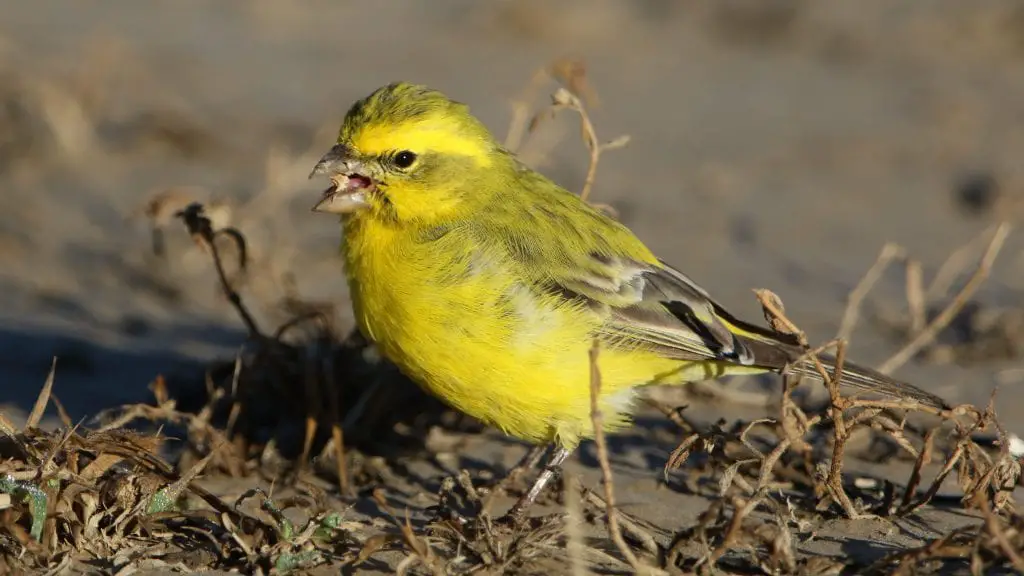
The canaries are some of the most widely available birds in the global pet industry. When looking for a yellow canary for sale, one will inevitably come across a fairly large selection of characteristics found in the different types of canaries, such as size, song, shape, feathering, and color.
If you want to train your yellow canary and establish a strong bond with the feathery creature, it is best to get a young yellow canary that has just completed its first molt. The easiest way to get a young canary is to look for one in the autumn, as the autumn season is just before the very end of the breeding season.
Being fairly inexpensive and easy to take care of, yellow canaries, among other canaries, are bird species that one can find effortlessly from a variety of online and offline vendors or breeders.
Interesting Facts
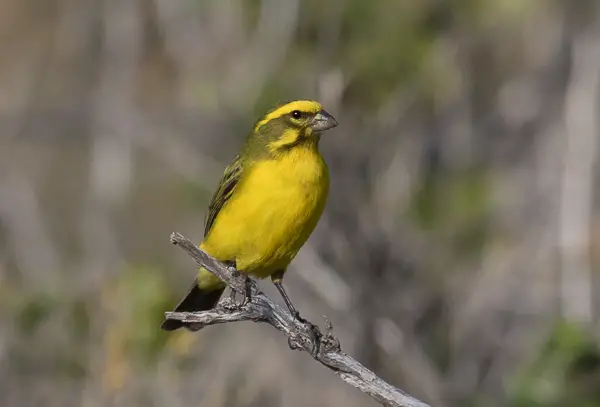
1. The domesticated canary’s ancestor is found in the Canary Islands, Madeira, and the Azores. Ever since 1478, when the first wild-caught canaries were imported into Europe, the domestic canary breeds have greatly changed and evolved.
2. It was in 1478 when canaries were first introduced to Spain by the Spaniards, who got to conquer the Canary Islands. It was for over 100 years that the Spaniards managed to maintain full control of these incredible, small-sized birds, by selling only male canaries to other European countries, thus, preventing any breeding attempts outside Spain.
However, it was in the 16th century when a shipping accident occurred, causing large cargo of canaries to escape and then fly away to the Island of Elba. Soon after this shipping accident, canaries became widely available for sale all over Europe, marking the beginning of the development of many different canary breeds.
3. It was yellow canaries to have been used during earlier times for the purpose of alerting coal miners about potential mine explosion.
This was possible because of canaries’ susceptibility to respiratory problems, with methane or carbon monoxide causing great damage to the birds. Thus, if miners were to notice any sign of illness in yellow canaries brought in the mines, the miners were to leave the ground immediately. It is fair to state that yellow canaries have managed to save the lives of thousands of miners.
4. According to a 2016 research led by the University of Southampton, similarly to the way coal miners used canaries for checking for deadly, poisonous gases found deep underground, there are “ecosystem canaries” species that can help humans understand when an ecosystem is damaged, approaching a tipping point. These species are the ones that are often the first to disappear from a severely stressed, endangered ecosystem.
The vanishing of “ecosystem canaries” can be related to negative changes in the way the ecosystem functions, therefore, serving as a warning that a tipping point is just around the corner.
According to the researchers, currently, conservation efforts are mainly focused on large, enigmatic animals, such as whales and tigers, among others. And while there are many reasons to do everything possible to save these legendary species from extinction, the majority of life that we barely even notice, such as the canaries, grubs, and bugs, can also appear or disappear from ecosystems, without any easily apparent impact.
Researchers believe that it is possible for vital information regarding the overall resilience and health of an ecosystem to be lurking in data, and in particular, when it comes to what we could possibly consider as inconsequential species.
The intriguing research was published in the journal Ecology. The research used ecosystem canaries in order to reveal and show early warning indications of reaching a tipping point in three of China’s lake ecosystems.
Most importantly, the researchers believe that this new technique can be potentially applied to many other habitats. By using the power of “ecosystem canaries,” we can gain an increased, better understanding of the way these species respond to human impacts, such as climate change, deforestation, and overfishing, among others.
How to Care for the Yellow Canary
1) Taming & Handling
Most of the time, similarly to other canaries, the yellow canary is enjoyed for its sweet singing skills, as well as for its natural beauty. However, it is fully possible to commit to training or taming a yellow canary, so that the bird can be allowed to get out of its cage to perch. Also, it is not uncommon for dedicated aviculturists to train their canaries as to turn them into show canaries.
Above all, one must remember that taming a canary takes a lot of patience, and nonetheless, persistent effort.
Even though they can learn some simple tricks, for instance, playing with a particular toy, these birds are very timid creatures in general, and so they should be approached with respect and tact.
Male canaries that are exposed to particular sounds on a regular basis from an early age, e.g., a doorbell sound or a telephone ring sound, can learn to mimic these sounds perfectly over time.
As a rule of thumb, taming or training a yellow canary is to be much easier when the bird is still young and is also easiest when it comes to dealing only with a single bird.
Wing clipping can be also helpful in the taming/training process because of inhibiting the bird’s ability to simply choose to fly away, however, it is not a must to wing clip the bird in order to train it/tame it, and in fact, there is always the moral point on whether it is humane to wing clip the feathery fellow or not at all.
Handling should only take place when the yellow canary is perfectly well-used to the caregiver, and only when the bird is at ease. Excess handling must be avoided, as it will stress the animal and decrease its longevity.
When handling a canary, the caregiver should place his/her palm on the canary’s back. Next, the caregiver should wrap his/her fingers gently around the bird, while the forefinger and the thumb the on either side of the head. The canaries may attempt to bite, although this happens very rarely. Plus, the canaries’ bites are not at all dangerous and are not really harmful to the caregiver.
Up-to-date, it is still the norm for many people to consider canaries totally untrainable. This is not the truth, as canaries are perfectly trainable birds, but they do require a different approach than the most common training/taming approaches applied to most of the other cage birds.
For those who can get a recently weaned, young canary, hand-taming the bird is much easier, and it can produce an amazing, adorable pet.
2) Diet
Yellow canaries, just like other canaries, require a well-balanced, nutritional diet in order to thrive.
- About 60% – 70% of the diet should be made up of specialized pellets. Additionally, fresh fruits and veggies can be offered, as well as a moderate amount of fortified seeds.
- Daily access to fresh, filtered, chlorine-free, clean water is a must. Water must be provided and changed on a daily basis.
- Do not feed fruit seeds, chocolate, avocado, high fat, or high sugar treats.
3) Feeding
When feeding a canary, there are certain things to remember for the best results.
- Discard any remnants from fruits and/or veggies that have not been fully eaten within a few hours after having being provided. Freshwater and fresh food should be available at all times.
- The occasional treats you provide must not exceed 10% of the total food intake.
4) Housing Requirements
- The canaries thrive when exposed to average household temperatures, as long as the temperatures do not exceed 80 degrees Fahrenheit. These birds must not be exposed to extreme changes in temperature. Also, they must be always well-protected from drafts, and so the cage should be placed off the floor in a well-lit spot.
- A yellow canary should be provided a suitable flight habitat. The cage for housing a single newly acquired canary should be about 18’’ wide, 14’’ deep and 18’’ high. Cages with metal bars are strongly recommended, with the metal bars featuring spacing that is not any more than 3/8’’. As soon as the bird is to acclimate, the largest habitat possible should be provided to ensure the health, happiness, and well-being of the feathery creature.
- Provide a variety of perches to allow the canary to exercise its feet properly. Also, perches will help to prevent arthritis. Opt for perches that are at least ¼’’ – ½’’ in diameter, and at least 3’’ in length.
- To keep the bird away from droppings, utilize a metal grate placed right over the droppings tray. For easier cleaning, as well as to avoid possible contamination, do line the droppings tray with the appropriate substrate (habitat paper works great). Do never place water or food containers under perches.
- Male canaries should not be housed together, as they are highly likely to become aggressive towards each other. However, it is strongly recommended to keep a yellow canary with at least one other canary in the room, yet in separate cages. As a rule of thumb, canaries are the happiest when surrounded by as many more canaries as possible. Do note that housing different types of birds together with the canaries are not recommendable, although there may be certain exceptions on that note.
- In order to bond with each other, canaries should be kept in pairs. Additionally, is it best for the pet parent to socialize daily with the canary.
Normal Behavior
1. The canaries need enough room to fly in their habitat.
2. Mental stimulation is crucial, and so foraging toys are strongly recommended.
3. It is male canaries that are known for their delightful singing skills. Female canaries do not really sing, but rather than that, they chirp.
4. If a male yellow canary is kept in a habitat with mirrors, it is often the case that the bird may not sing.
Social Behaviors/Personality
1. Yellow canaries, just like all other canaries that can be kept as pets, are very social birds. Also, they are known for their good personalities.
2. The canaries make wonderful children-friendly pets. These birds will not harm kids, other pets, or guests.
3. Make sure not to cohabitate yellow canaries with lovebirds or parakeets, or any other hookbills, as these birds tend to be much more aggressive by nature than the shy, timid canaries, and can, therefore, cause serious damage to the canaries.
4. It is possible to house canaries with other hardbills, such as finches and other canaries alike, as long as the group is provided a spacious cage to thrive. If you are to pair up two male canaries in a cage, though, expect for fights to occur.
5. Do you mind that canaries dislike being handled in general? Only occasionally, there might be exceptions on that note, but it remains a must to respect the animal and to not force it into being handled. These timid, shy, charming birds will greatly enjoy watching their owners, as well as actively interacting with them from the safe comfort of their flight cage.
Activities
1. To ensure the health and comfort of a canary, including but not limited to the yellow canary alone, the bird must be granted to ability to move around, flying freely from one perch to another.
2. To allow the much-needed free movement, keep cage accessories to a bare minimum. A single branch, a single mirror, or a single toy will be plenty to keep the bird entertained.
3. To provide the canary with some variety and further mental stimulation, periodically move the cage accessories around, and also switch them from time to time.
4. In the wild, canaries are known to adore rolling in grass dampened by dew, thus, taking a delightful bath. To give your yellow canary a treat, you can occasionally place damp grasses or damp leaves (dandelion leaves work great), right at the bottom of the cage for 1-2 hours.
Alternatively, you can provide a fun bath for your canary by making use of an enclosed birdbath placed in the cage 1-3 times weekly. Always be careful not to let the bird get cold, and for this purpose, bathe the bird in the morning/ early afternoon to give it enough time to dry completely before it’s time for sleeping.
Breeding
1. Even though canaries are fairly easy to take care of pets, and they are also favored for their relative contentment when it comes to doing just fine on their own, the captive breeding process requires some careful planning, specialized tools, the right food, and nonetheless, a bit of luck.
2. Make sure the breeding pair gets no less than 14 hours of light per day. Keep temperatures in the 70 degrees Fahrenheit range.
3. The breeding season typically begins in mid-March, so it is at some point in this period when the male and the female canaries should be placed in their breeding cage.
Other breeding supplies include a nest for breeding canaries, nesting material (the female will then add the nesting material to the pre-made nest).
4. The canaries should be kept in separate cages until the time to breed kicks in. The cages with the male and the female canary can be kept in the same room prior to introducing the pair in their breeding cage or prior to bringing the two separate cages closer to one another if a specialized breeding cage is not available.
5. Place the pair of canaries in a breeding cage with a central divider. Alternatively, in the absence of a breeding cage, get the two cages with the male and the female birds close to each other but without hurrying to introduce them in the same cage. Monitor their behavior to know when they are fully ready to breed. When they are ready to breed, both the male and the female canary will act differently.
6. Provide a nest, as well as nesting material. Place the nest on the female’s side of the breeding cage, or in the female’s cage in the case you are not making use of a breeding cage. The female will “tell” she is ready to mate when she starts adding some of the nesting material in the nest.
7. The diet of nesting canaries should consist of:
60% – 70% pelleted food
20% enriched seed
10% of soft food
Calcium (additional calcium should be provided a few weeks before breeding and up until the point when the canaries stop feeding their young chicks).
To help the male produce healthy eggs, cuttlebone, or grit is strongly recommended.
8. Once the canaries are ready to breed, they will start “kissing” each other through the cage’s bars by touching each other’s beak. Kissing may start after only a few hours or after a couple of days after the pair has been placed in the breeding cage with a central divider or after the two separate cages have been placed close to each other. When kissing begins, the canaries can be placed in the same cage, or in the case of using a breeding cage; the central divider can be removed.
9. Mating is fairly aggressive, and in the case, the breeder is still a beginner, mating can pretty much resemble fighting. It is important to remember that if the breeding pair is not mating but fighting, the birds must be separated.
10. After successfully mating with the male, the female canary is to lay one single egg a day, usually early in the morning. The canaries can lay up to 6 eggs in a single clutch, so egg laying may take anything from 2 days to 6 days. The young chicks will hatch without any assistance.
11. The young chicks should be separated from the parents as soon as they start eating on their own and are fully-fledged. At the point when the young chicks are to be moved in their own cages, the breeding pair should be also separated.
Habitat Maintenance
1. The substrate should be replaced weekly. Sometimes, the caregiver may need to change the habitat liner/substrate more often, as necessary.
2. The perches, as well as the entire habitat, should be thoroughly cleaned and disinfected on a regular basis.
3. Neither any of the habitat parts, nor any of the toys, should include galvanized pieces, zinc, lead, or lead-based paints. If ingested by the bird, these can cause serious health problems.
4. Rotate new toys into the habitat on a regular basis but always allow the bird to get better used to the new toy before placing it inside the cage. When damaged or worn, dishes, toys, and perches should be replaced as soon as feasible.
5. Stay away from applying a lot of cleaning agents around your canary. The related fumes can easily harm the birds’ health and well-being. Instead, opt for natural cleaning products, and always make sure to keep the bird in another room if disinfecting the habitat with commercial-grade, non-natural cleaning products.
Hygiene & Grooming
1. Chlorine-free, filtered, clean, lukewarm water should be used for regularly bathing canaries. When the bathing is done, water should be immediately removed. Alternatively, the bird can be misted with water, too.
2. To prevent unwanted injuries, the canary’s nails should be trimmed by a professional.
For those who are interested in acquiring a yellow canary, below is a neat shopping list of all the essentials needed to welcome your new bird pet into the family.
1. Appropriately-sized, flight-type cage habitat + habitat cover
2. Millet spray
3. Cuttlebone
4. Millet/cuttlebone holder
5. High-quality canary food
6. Habitat paper/substrate
7. A variety of perches and toys
8. Water and food dishes
9. Birdbath
10. Grooming supplies
FAQ Section
Why Are Canaries Yellow?
The most popular canaries in the domesticated canaries’ category include the red-factor and the yellow (clear) canary, both of which are achieved by color-breeding canaries for their vivid color. Some canaries are also fed naturally pigmented food for the purpose of enhancing their colors.
What Does a Yellow Canary Look like?
The yellow canary (Crithagra flaviventris) is a species of canary native to South Africa. The adult male yellow canary can be uniformly yellow or Olive-backed and streaked, with the tail sides, rump, and underparts being yellow in color, while the female yellow canary’s upperparts are grey-brown in color, and are “equipped” with yellow flight feathers.
How Much is a Yellow Canary?
Usually, it is possible to find a yellow canary available for sale at relatively low prices, typically in the $100 – $150 price range.
Where Do Yellow Canaries Come from?
Yellow canaries are native to South Africa; however, the domesticated form of the popular yellow canary dates back to the 17th century, in particular, the year 1670. The easily recognizable bright yellow plumage has been further developed through selective breeding, as the descendants of wild canaries gradually gave way to the domesticated form Serinus canaria domestica.
How Big Is a Yellow Canary?
The yellow canary usually reaches about 13 cm in length. Although rarely, yellow canaries may reach up to 15 cm in length.
Can a Canary and a Finch Mate?
Yes, a canary and a finch can mate, with the possible mating giving way to a hybrid breed of bird known as a mule. By mating a canary and a finch, breeders are capable of producing a healthy, melodic offspring, living for longer than the domesticated canary usually does.
How Do I Know if my Canary is about to Lay Eggs?
As soon as the canaries are spotted carrying paper and string in their beaks, this means the pair is very close to breeding, with breeding typically taking place very early in the morning. It is usually early in the morning when the female is to lay an egg.
Is the Yellow Canary Endangered?
The yellow canary is listed as Least Concern on the IUCN Red List of Threatened Species, with the current population of yellow canaries in the wild being estimated as stable based on the August 2018 global assessment.

